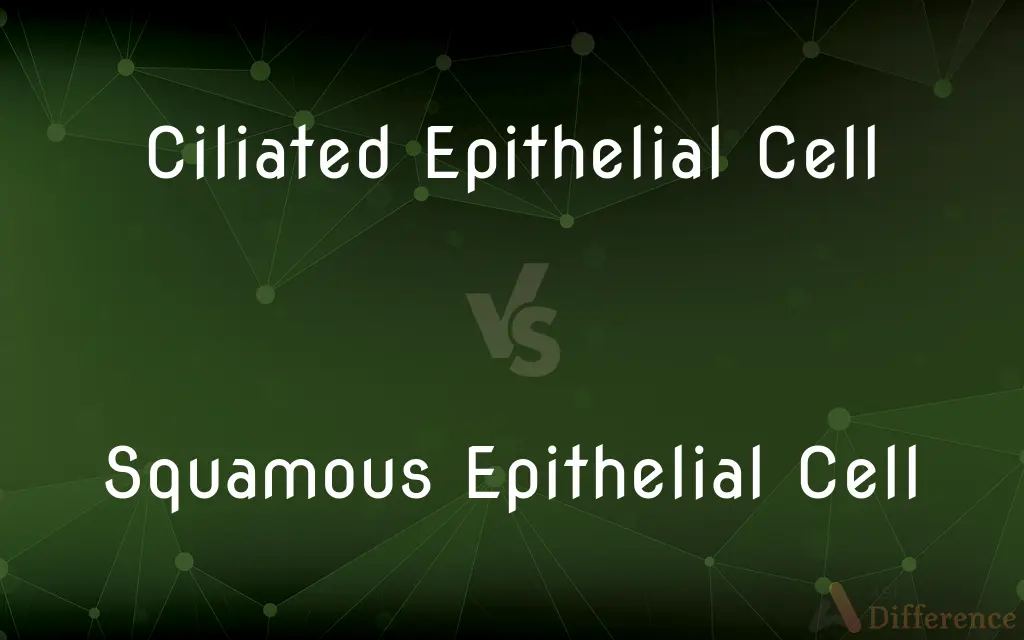Ciliated Epithelial Cell vs. Squamous Epithelial Cell — What's the Difference?
By Tayyaba Rehman — Published on January 1, 2024
Ciliated epithelial cells have hair-like structures and aid in movement of substances, while squamous epithelial cells are flat and form protective layers.

Difference Between Ciliated Epithelial Cell and Squamous Epithelial Cell
Table of Contents
ADVERTISEMENT
Key Differences
Ciliated epithelial cells are characterized by the presence of tiny hair-like structures called cilia on their surface. These cilia are involved in the movement of substances across the cell surface. Squamous epithelial cells, on the other hand, are flat and thin, resembling tiles, and are primarily involved in providing a protective barrier.
Both ciliated and squamous epithelial cells are essential for bodily functions but differ in structure and function. Ciliated epithelial cells are commonly found lining the respiratory tract, where they help move mucus and trapped particles. Squamous epithelial cells are widespread, forming the outer layer of skin and lining various organs.
Ciliated epithelial cells actively participate in the defense mechanisms of the body by trapping and removing debris. Squamous epithelial cells, in contrast, act as a passive barrier, protecting underlying tissues from damage and dehydration.
Despite their differences, both cell types are integral to maintaining homeostasis. Ciliated epithelial cells ensure the cleanliness of internal passages, while squamous epithelial cells provide a first line of defense against environmental factors.
In terms of regeneration, both ciliated and squamous epithelial cells have the ability to rapidly divide and replace damaged cells, albeit with different rates and mechanisms. This regenerative capacity is vital for tissue maintenance and repair.
ADVERTISEMENT
Comparison Chart
Structure
Hair-like cilia on surface
Flat, tile-like appearance
Function
Movement of substances, trapping particles
Protective barrier, preventing damage and dehydration
Location
Respiratory tract, fallopian tubes
Skin, lining of mouth, esophagus, alveoli in lungs
Role in Defense
Active participation in trapping debris
Passive protective barrier
Regeneration
Rapid cell division for replacement
Rapid cell division, especially in skin
Compare with Definitions
Ciliated Epithelial Cell
Has hair-like structures for particle transport.
Ciliated cells prevent dust particles from entering the lungs.
Squamous Epithelial Cell
Can be found in single or multiple layers.
The alveoli in lungs are lined with thin squamous cells.
Ciliated Epithelial Cell
A cell with cilia for movement of substances.
Ciliated epithelial cells line the trachea, helping to clear mucus.
Squamous Epithelial Cell
Flat, scale-like protective cells.
The outer layer of skin is composed of squamous epithelial cells.
Ciliated Epithelial Cell
Capable of rapid regeneration.
Damaged ciliated cells in the airway can quickly replenish.
Squamous Epithelial Cell
Rapidly divides for repair and renewal.
Skin cells rapidly regenerate, especially after an injury.
Ciliated Epithelial Cell
Found in respiratory and reproductive systems.
These cells aid in the movement of egg cells in the fallopian tubes.
Squamous Epithelial Cell
Provides barrier against pathogens and dehydration.
Squamous cells in the skin prevent excessive water loss.
Ciliated Epithelial Cell
Plays a role in the body's defense mechanism.
Inhaled bacteria are trapped and moved out by ciliated cells.
Squamous Epithelial Cell
Forms linings of organs and cavities.
The mouth's interior is lined with squamous cells.
Common Curiosities
What characterizes squamous epithelial cells?
They are flat, thin, and form protective layers.
What happens if ciliated cells are damaged?
It can lead to reduced mucus clearance and respiratory issues.
What is the main function of ciliated epithelial cells?
To move substances and trap particles using cilia.
How do ciliated cells contribute to respiratory health?
By removing mucus and foreign particles from the airways.
Can squamous epithelial cells be found in the lungs?
Yes, they line the alveoli for gas exchange.
Are squamous cells involved in sensation?
Yes, those in the skin are part of sensory perception.
Do ciliated epithelial cells have a role in fertility?
Yes, they help move the egg through the fallopian tubes.
Are squamous cells found in the digestive system?
Yes, they line parts of the mouth and esophagus.
What is the lifespan of squamous epithelial cells in the skin?
They have a relatively short lifespan and are continuously shed and replaced.
Can squamous epithelial cells become cancerous?
Yes, prolonged damage can lead to squamous cell carcinoma.
Where are ciliated epithelial cells located?
In the respiratory tract and parts of the reproductive system.
Do squamous cells contain keratin?
Yes, especially those in the skin, for added protection.
Do ciliated epithelial cells have a high regeneration rate?
Yes, they can rapidly regenerate and replace damaged cells.
How do ciliated cells affect asthma?
In asthma, ciliated cell function can be impaired, affecting mucus clearance.
Can both ciliated and squamous cells be found in the respiratory system?
Yes, but they serve different functions in different regions.
Share Your Discovery

Previous Comparison
Data Encryption Standard vs. Advanced Encryption Standard
Next Comparison
Reverse Lookup Zone vs. Forward Lookup ZoneAuthor Spotlight
Written by
Tayyaba RehmanTayyaba Rehman is a distinguished writer, currently serving as a primary contributor to askdifference.com. As a researcher in semantics and etymology, Tayyaba's passion for the complexity of languages and their distinctions has found a perfect home on the platform. Tayyaba delves into the intricacies of language, distinguishing between commonly confused words and phrases, thereby providing clarity for readers worldwide.
















































